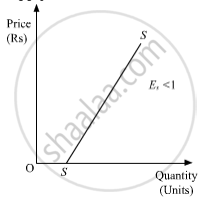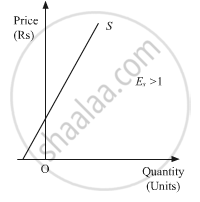Advertisements
Advertisements
प्रश्न
Answer the following about 200 to 250 words
Explain various methods to measure Price Elasticity of Supply.
उत्तर
The price elasticity of supply can be measured by the following two methods namely:
1. Proportionate Method
2. Geometric Method
Proportionate or percentage method
According to this method, the price elasticity of supply is given, by the ratio of percentage change in the quantity supplied and percentage change in the price of commodity.
Algebraically, it can be expressed as:
`Es = "Percentage Change in Quantity Supplied"/"Percentage Change in Price"`
Geometric method
The geometric method is a graphical presentation of the elasticity of the supply. This method does not involve any calculation. Just by looking at the shape of the supply curve, we can infer the degree of the elasticity of the supply. The degree of the price elasticity of supply depends on the slope and origin position of the supply curve.
There are following possible situations.
a. Unitary Elasticity of Supply (Es=1 )- If the straight line supply curve originates from the origin, then irrespective of the angle of inclination of the supply curve, the elasticity of supply will always be equal to one i.e. (Es=1 ). Such a supply curve is called unitary elastic supply curve.

b. Less Elastic Supply (Es < 1)- If the supply curve originates from the horizontal intercept of quantity-axis, then irrespective of the angle of inclination of the supply curve, the elasticity of the supply curve will be less than one i.e. (Es < 1).

c. More Elastic Supply (Es > 1)- Unlike the less elastic supply curve, the relatively more elastic supply curve originates from the vertical intercept of price-axis. The value of elasticity of supply originating from the vertical intercept is greater than one, i.e. (Es > 1).

APPEARS IN
संबंधित प्रश्न
Relatively elastic supply
Price is the only determinant of supply.
Elasticity of supply
Individual supply and Market supply.
A producer supplies 80 units of a good at a price of Rs 10 per unit. Price elasticity of supply is 4. How much will he supply at Rs 9 per unit?
When the price of a good rises from Rs 20 per unit to Rs 30 per unit, the revenue of the firm producing this good rises from Rs 100 to Rs 300. Calculate the price elasticity of supply.
When price of a commodity falls from Rs 12 per unit to Rs 9 per unit, the producer supplies 75 percent less output. Calculate price elasticity of supply.
When price of a good rises from Rs 10 to Rs 12 per unit the producer supplies 10 percent more. Calculate price elasticity of supply.
What is perfectly elastic supply?
When price falls by Rs 2 per unit, supply falls from 100 units to 80 units. Price elasticity of supply is 2. What was the price per unit before change?Calculate.
When price of a good rises from Rs 8 per unit to Rs 10 per unit, producer supplies 40 units more. Price elasticity of supply is 2. What is the quantity supplied before the price change? Calculate
Price elasticity of supply of a good is 2. A producer supplies 100 units of a good at a price of Rs 20 per unit. At what price will he supply 80 units?
When price of a good raises from Rs 12 per unit to Rs 15 per unit the producer supplies 50 per cent more output. What is the price elasticity of supply? Calculate.
When price of a good falls from Rs 20 to Rs 10 per unit, producer reduces supply from 100 units to 50 units. Calculate price elasticity of supply.
A producer supplies 100 units of a good at a price of Rs 20 per unit. Price elasticity of supply is 2. At what price will he supply 50 units? Calculate
When the price of a commodity changes from Rs 4 per unit to Rs 5 per unit, its market supply rises from 100 units to 120 units. Calculate the price elasticity of supply. Is supply elastic? Given reason
Explain the effect of technological progress on supply of a good.
What is supply?
Supply is inversely related to price.
Supply is directly related to price.
A firm supplies 10 units of a good at a price of Rs 5 per unit. Price elasticity of supply is 1.25. What quantity will the firm supply at a price of Rs 7 per unit?
State whether the following statement is true or false :
Supply of perishable goods is inelastic.
State whether the following statement is true or false :
Under perfect competition price is determined by equilibrium of demand and supply.
Give reason or explain the following statement:
A monopolist can control the supply of goods .
Give reason or explain the following statement:
The supply of land is inelastic .
Fill in the blank using proper alternative given in the bracket:
Other factors remaining constant, when price of a commodity raises there is ................. of supply.
Give reason or explain the following.
Supply is directly related to price.
Explain with reason, whether you agree or disagree with the following statement:
There is direct relationship between price and quantity supplied.
State whether the following statements are True or False:
Better transport facility increases supply at the same price.
Fill in the blank with appropriate alternatives given in the bracket:
________ is one of the determinants of aggregate supply.
Fill in the blank with appropriate alternative given below
When the price rises, there is __________ of supply.
Fill in the blank with appropriate alternative given below
The vertical supply curve represents _____________ elasticity.
Fill in the blank with appropriate alternative given below
An increase in supply means selling a ____________ amount at the same price.
State whether the following statement is TRUE and FALSE.
If price falls, the supply curve will shift to left.
State whether the following statement is TRUE and FALSE.
Geometric Method is also known as Point Method.
State whether the following statement is TRUE and FALSE.
Total Cost is the total expenditure incurred by a firm.
Define or explain the following concept:
Stock
Define or explain the following concept:
Output
Define or explain the following concept:
Elasticity of Supply
Give reason or explain:
With a slight change in the price, if supply varies in a greater proportion then supply is said to be relatively elastic.
Give reason or explain:
Stock can exceed supply.
Distinguish between the following:
Relatively Elastic Supply and Relatively Inelastic Supply
Write short note on the following:
Elasticity of supply.
Answer the following question:
What are the exceptions to the law of supply?
Do you agree or disagree with the following statement? Give reason.
There is no difference between stock and supply.
Do you agree or disagree with the following statement? Give reason.
Price is the only determinant of supply.
Answer the following about 200 to 250 words
What are the assumptions law of supply?
Answer the following about 200 to 250 words
State and explain the law of supply. What are the exceptions to this law?
Answer the following about 200 to 250 words
Explain various types of Price elasticity of Supply.
Give reason or explain the following.
Law of supply is not applicable to rare articles.
Choose the correct alternative from given options:
The coefficient of price elasticity of supply of a good is 3. It is known as ___________.
Observe the following table and answer the questions:
Supply schedule of chocolates
| Price in ₹ | Quantity supplied in units |
| 10 | 200 |
| 15 | ______ |
| 20 | 300 |
| 25 | 350 |
| 30 | ______ |
| 35 | ______ |
| 40 | ______ |
- Complete the above supply schedule.
- Draw a diagram for the above supply schedule.
- State the relationship between price and quantity supplied.
Identify & explain the concept from the given illustration.
Ajay’s papad and pickle producing unit incurred expenditure of ₹ 50,000/- on machinery, ₹ 1,00,000/- towards rent and ₹ 2,00,000/- on wages for the workers during 2018-19.
Study the following table, figure, passage and answer the question given below it.
| Price in Rs. | Quantity supplied |
| 10 | 300 |
| 20 | ______ |
| 30 | 400 |
| 40 | 450 |
| 50 | ______ |
| 60 | 550 |
| 70 | 600 |
- Complete the above table (1m)
- State the relationship between Price and quantity supplied (1m)
- Draw supply curve based on above supply schedule (2m)
